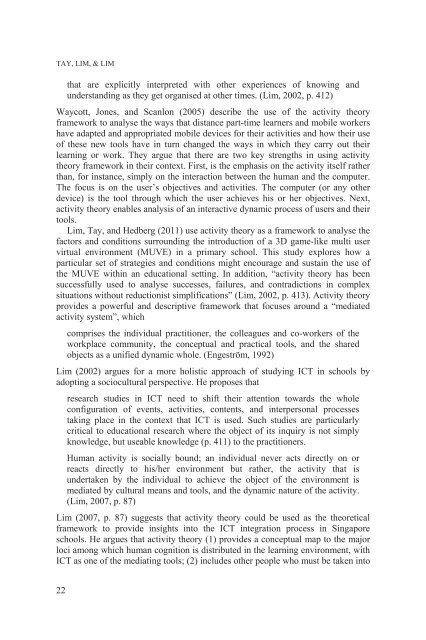1517-creating-holistic-technology-enhanced-learning-experiences
1517-creating-holistic-technology-enhanced-learning-experiences
1517-creating-holistic-technology-enhanced-learning-experiences
You also want an ePaper? Increase the reach of your titles
YUMPU automatically turns print PDFs into web optimized ePapers that Google loves.
TAY, LIM, & LIM<br />
that are explicitly interpreted with other <strong>experiences</strong> of knowing and<br />
understanding as they get organised at other times. (Lim, 2002, p. 412)<br />
Waycott, Jones, and Scanlon (2005) describe the use of the activity theory<br />
framework to analyse the ways that distance part-time learners and mobile workers<br />
have adapted and appropriated mobile devices for their activities and how their use<br />
of these new tools have in turn changed the ways in which they carry out their<br />
<strong>learning</strong> or work. They argue that there are two key strengths in using activity<br />
theory framework in their context. First, is the emphasis on the activity itself rather<br />
than, for instance, simply on the interaction between the human and the computer.<br />
The focus is on the user’s objectives and activities. The computer (or any other<br />
device) is the tool through which the user achieves his or her objectives. Next,<br />
activity theory enables analysis of an interactive dynamic process of users and their<br />
tools.<br />
Lim, Tay, and Hedberg (2011) use activity theory as a framework to analyse the<br />
factors and conditions surrounding the introduction of a 3D game-like multi user<br />
virtual environment (MUVE) in a primary school. This study explores how a<br />
particular set of strategies and conditions might encourage and sustain the use of<br />
the MUVE within an educational setting. In addition, “activity theory has been<br />
successfully used to analyse successes, failures, and contradictions in complex<br />
situations without reductionist simplifications” (Lim, 2002, p. 413). Activity theory<br />
provides a powerful and descriptive framework that focuses around a “mediated<br />
activity system”, which<br />
comprises the individual practitioner, the colleagues and co-workers of the<br />
workplace community, the conceptual and practical tools, and the shared<br />
objects as a unified dynamic whole. (Engeström, 1992)<br />
Lim (2002) argues for a more <strong>holistic</strong> approach of studying ICT in schools by<br />
adopting a sociocultural perspective. He proposes that<br />
research studies in ICT need to shift their attention towards the whole<br />
configuration of events, activities, contents, and interpersonal processes<br />
taking place in the context that ICT is used. Such studies are particularly<br />
critical to educational research where the object of its inquiry is not simply<br />
knowledge, but useable knowledge (p. 411) to the practitioners.<br />
Human activity is socially bound; an individual never acts directly on or<br />
reacts directly to his/her environment but rather, the activity that is<br />
undertaken by the individual to achieve the object of the environment is<br />
mediated by cultural means and tools, and the dynamic nature of the activity.<br />
(Lim, 2007, p. 87)<br />
Lim (2007, p. 87) suggests that activity theory could be used as the theoretical<br />
framework to provide insights into the ICT integration process in Singapore<br />
schools. He argues that activity theory (1) provides a conceptual map to the major<br />
loci among which human cognition is distributed in the <strong>learning</strong> environment, with<br />
ICT as one of the mediating tools; (2) includes other people who must be taken into<br />
22


